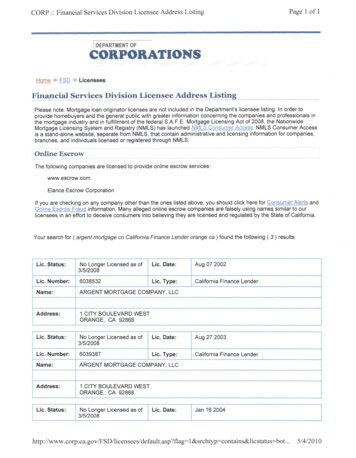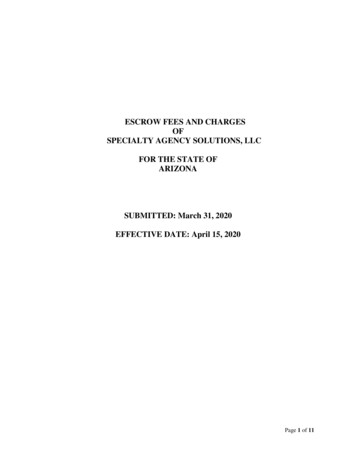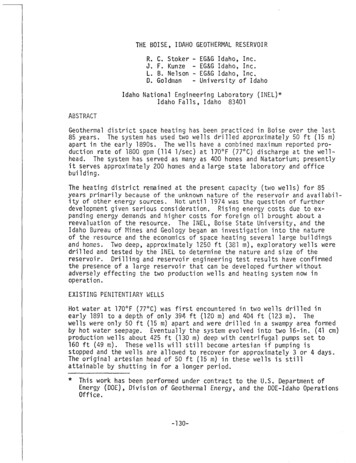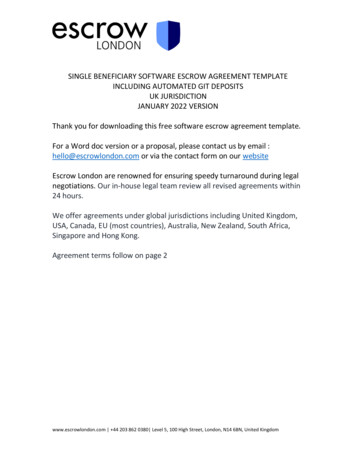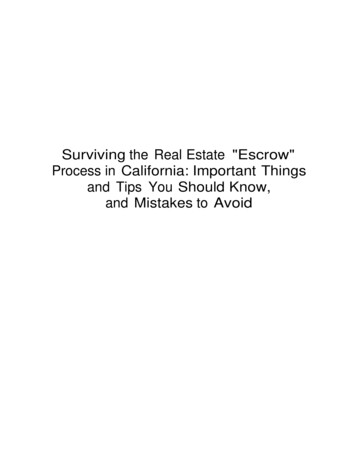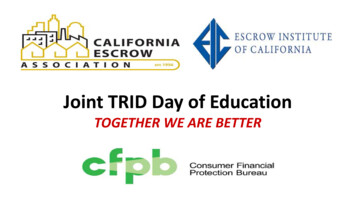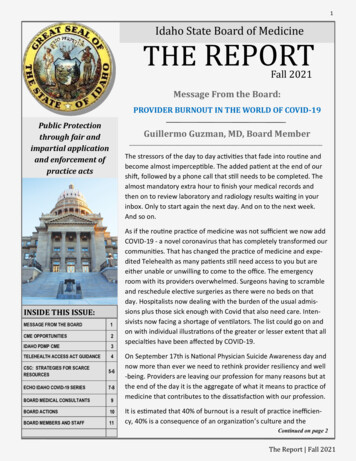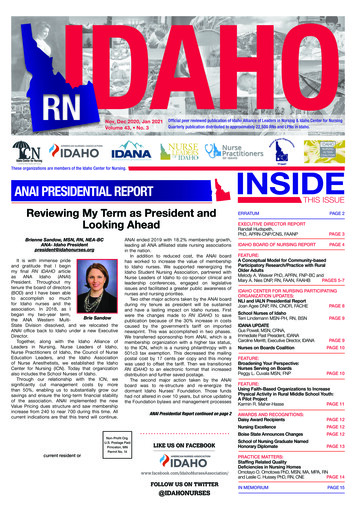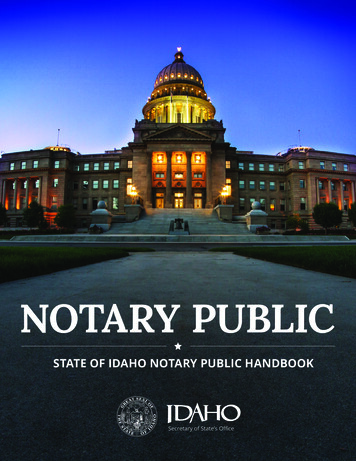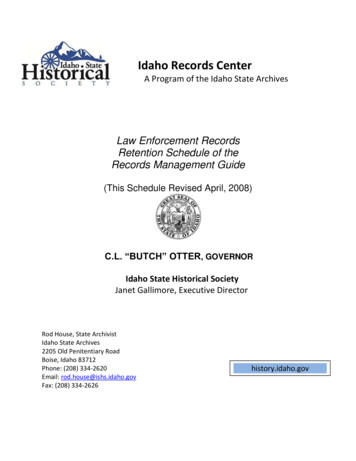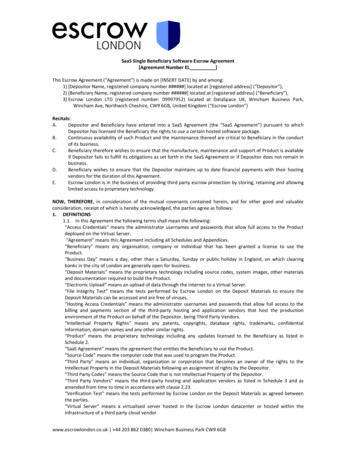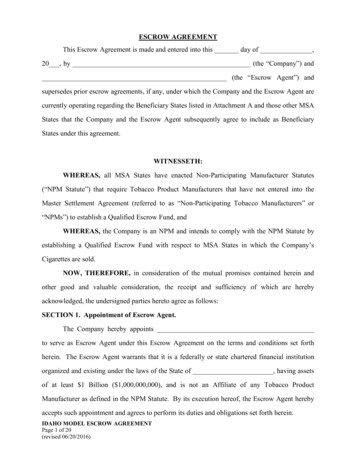
Transcription
ESCROW AGREEMENTThis Escrow Agreement is made and entered into this day of ,20 , by (the “Company”) and(the “Escrow Agent”) andsupersedes prior escrow agreements, if any, under which the Company and the Escrow Agent arecurrently operating regarding the Beneficiary States listed in Attachment A and those other MSAStates that the Company and the Escrow Agent subsequently agree to include as BeneficiaryStates under this agreement.WITNESSETH:WHEREAS, all MSA States have enacted Non-Participating Manufacturer Statutes(“NPM Statute”) that require Tobacco Product Manufacturers that have not entered into theMaster Settlement Agreement (referred to as “Non-Participating Tobacco Manufacturers” or“NPMs”) to establish a Qualified Escrow Fund, andWHEREAS, the Company is an NPM and intends to comply with the NPM Statute byestablishing a Qualified Escrow Fund with respect to MSA States in which the Company’sCigarettes are sold.NOW, THEREFORE, in consideration of the mutual promises contained herein andother good and valuable consideration, the receipt and sufficiency of which are herebyacknowledged, the undersigned parties hereto agree as follows:SECTION 1. Appointment of Escrow Agent.The Company hereby appointsto serve as Escrow Agent under this Escrow Agreement on the terms and conditions set forthherein. The Escrow Agent warrants that it is a federally or state chartered financial institutionorganized and existing under the laws of the State of , having assetsof at least 1 Billion ( 1,000,000,000), and is not an Affiliate of any Tobacco ProductManufacturer as defined in the NPM Statute. By its execution hereof, the Escrow Agent herebyaccepts such appointment and agrees to perform its duties and obligations set forth herein.IDAHO MODEL ESCROW AGREEMENTPage 1 of 20(revised 06/20/2016)
SECTION 2. Definitions.A. Capitalized terms used in this Escrow Agreement and not otherwise defined hereinor in the Beneficiary State’s NPM Statute shall have the meaning given to such terms in theMaster Settlement Agreement.B. “Beneficiary State” means a MSA State for whose benefit funds are beingescrowed pursuant to the NPM Statute. For purposes of this Escrow Agreement, the initialBeneficiary States are those listed in Attachment A hereto, which is hereby incorporated hereinby reference, and those other MSA States that the Company and the Escrow Agent may hereafteragree to include as Beneficiary States. Escrow Agent is authorized to include other BeneficiaryStates under this Escrow Agreement by written notice from the Company and is furtherauthorized to revise Attachment A from time to time to reflect additional Beneficiary States asinstructed by the Company.C.“Cost Basis” means (i) for cash, the dollar amount deposited, and (ii) for the otherPermitted Investments, the amount paid, excluding accrued interest, by the holder to buy theUnited States Treasury Securities or the Money Market Fund shares. These amounts may also beknown as the tax basis, book value, or tax cost basis.D. “Face Value” means (i) for cash, the dollar amount deposited, (ii) for MoneyMarket Funds, the number of shares held multiplied by the stated value per share, and (iii) forUnited States Treasury Securities, the amount of principal owed to the holder upon maturity ofthe security. These amounts may also be known as the par value or principal value.E.“Master Settlement Agreement” or “MSA” means the settlement agreemententered into in 1998 by the four largest United States’ tobacco manufacturing companies (the“Original Participating Manufacturers” or “OPMs”) and 46 states of the United States (excludingTexas, Florida, Minnesota, and Mississippi), the District of Columbia, Guam, Northern MarianaIslands, the U.S. Virgin Islands, Puerto Rico, and American Samoa to settle certain claimsagainst the OPMs arising out of the sale, advertising, and consumption of certain tobaccoproducts, including Cigarettes, a copy of which has been provided to the Escrow Agent by theIDAHO MODEL ESCROW AGREEMENTPage 2 of 20(revised 06/20/2016)
ey Market Fund” means a money market mutual fund invested solely inUnited States Treasury Securities and/or cash and regulated under Rule 2a-7 of the InvestmentCompany Act of 1940.G. “MSA State” means any one of the 46 states of the United States (excluding Texas,Florida, Minnesota, and Mississippi), the District of Columbia, Guam, Northern Mariana Islands,the U.S. Virgin Islands, Puerto Rico, and American Samoa, which jurisdictions settled under theMSA.H. “NPM Statute” means the law or laws, as amended, enacted in each MSA Statethat require a Non-Participating Manufacturer to establish a Qualified Escrow Fund.TheCompany shall provide a copy of the NPM Statute for each Beneficiary State under this EscrowAgreement to the Escrow Agent.I.“Permitted Investments” means the ways in which QEF Principal may beinvested, which shall be limited to the following: (a) United States Treasury Securities, (b) cash,or (c) Money Market Fund.J.“Qualified Escrow Fund” means an escrow arrangement with a federally or statechartered financial institution having no affiliation with any Tobacco Product Manufacturer andhaving assets of at least one billion ( 1,000,000,000) where such arrangement requires that suchfinancial institution hold the escrowed funds’ principal for the benefit of Releasing Parties (asdefined in the Master Settlement Agreement) and prohibits the Tobacco Product Manufacturerplacing the funds into escrow from using, accessing or directing the use of the funds’ principalexcept as consistent with the applicable NPM Statute and this Escrow Agreement.K. “Qualified Escrow Fund Account” or “QEF Account” means an escrow accountconsisting of segregated sub-accounts for each Beneficiary State established by the Companyand maintained by the Escrow Agent into which the deposits required under the applicable NPMStatute are made.IDAHO MODEL ESCROW AGREEMENTPage 3 of 20(revised 06/20/2016)
L.“Qualified Escrow Fund Principal” or “QEF Principal” means the fundsrequired by the applicable NPM Statute to be deposited and held for the benefit of one or moreBeneficiary States in the QEF Account.M. “Qualified Escrow Fund Accumulated Principal” or “QEF AccumulatedPrincipal” means the aggregate amount of QEF Principal required to be held in each BeneficiaryState’s QEF Sub-Account.N. “Qualified Escrow Fund Sub-Account” or “QEF Sub-Account” means the subdivision of the QEF Account that holds only the QEF Principal deposited for the benefit of asingle Beneficiary State.O. “Sales Year” means the calendar year during which the Company sold Cigarettesin a Beneficiary State requiring the deposit of QEF Principal.P.“United States Treasury Securities” means bills, notes, and bonds issued by theUnited States Treasury (i) maturing no more than (20) twenty years from the date of purchase bythe Company, (ii) that are direct obligations (other than an obligation subject to variation inprincipal repayment) of the United States government, and (iii) backed by the full faith and creditof the United States of America; provided however, that United States Treasury Securities (iv)shall not include state and local government series securities of the United States Treasury.SECTION 3. The Qualified Escrow Fund Account and Release of Funds Therefrom.A. From time to time the Company shall tender to the Escrow Agent for deposit in theQEF Account the funds that the Company is required to place into a Qualified Escrow Fundpursuant to the NPM Statute of each Beneficiary State.The Company may appoint anauthorized representative or agent, acting on its behalf, to give directions permitted of theCompany under this Escrow Agreement, provided that in so doing, the Company shall alsoprovide the Escrow Agent and the Attorney General for the Beneficiary States with evidence ofthat authorized appointment.IDAHO MODEL ESCROW AGREEMENTPage 4 of 20(revised 06/20/2016)
B. All funds received by the Escrow Agent pursuant to the terms of this EscrowAgreement shall be held, invested, and disbursed in accordance with the terms and conditions ofthis Escrow Agreement and the applicable NPM Statute, regardless of the source of the funds—whether the funds are paid by the Company or by a third-party such as a Cigarette importer or anentity sharing liability with the Company for making the required QEF Principal deposits.C. For each Beneficiary State in which the Company’s Cigarettes were sold afterenactment of that Beneficiary State’s NPM Statute, the Company shall deliver to the EscrowAgent for deposit pursuant to this section the following amounts as such amounts are adjustedfor inflation pursuant to Exhibit C of the Master Settlement Agreement:1999:2000:2001 through 2002:2003 through 2006:2007 and thereafter:0.0094241 per Unit Sold0.0104712 per Unit Sold0.0136125 per Unit Sold0.0167539 per Unit Sold0.0188482 per Unit SoldD. The Company shall make deposits as frequently as required by the NPM Statute ofthe applicable Beneficiary State. Typically, the NPM Statute requires deposits annually orquarterly.E.Segregated QEF Sub-Accounts:1.The Company shall designate to the Escrow Agent the amount to beplaced in the QEF Sub-Account by Sales Year for each Beneficiary State based on theUnits Sold therein in accordance with the applicable Beneficiary State’s NPM Statute.All funds shall be held by the Escrow Agent in QEF Sub-Accounts separate and apartfrom all other funds of the Escrow Agent and the Company. The Escrow Agent shallallocate all funds as designated by the Company and received by the Escrow Agentamong the applicable Beneficiary States, each with its own separate, segregated QEFSub-Account and its own QEF Sub-Account number.2.The Escrow Agent shall place and hold such funds in each QEF Sub-Account for the benefit of the applicable Beneficiary State or any Releasing Party locatedIDAHO MODEL ESCROW AGREEMENTPage 5 of 20(revised 06/20/2016)
or residing in the applicable Beneficiary State. The Escrow Agent shall further show aBeneficiary State’s QEF Sub-Account by Sales Year to identify the amount of QEFPrincipal attributable to Units Sold in each Sales Year.3.Within the QEF Account established under this Escrow Agreement, theEscrow Agent shall maintain a separate QEF Sub-Account for each Beneficiary Statesufficient to enable tracking of (a) the QEF Principal allocated to each Beneficiary State,(b) all dates, transaction descriptions, and amounts of deposits, withdrawals, interest orother appreciation on each QEF Sub-Account, and (c) all investments of QEF Principalheld in each QEF Sub-Account. The Escrow Agent may also maintain within the QEFAccount a separate sub-account for the benefit of the Company to which interest or otherappreciation on the QEF Principal (the “Interest Account”) may be deposited.4.Upon receipt of authorized written notice from the Company, the EscrowAgent shall establish additional QEF Sub-Accounts for additional Beneficiary States,which shall be subject to the terms and conditions of this Escrow Agreement.F.The Company shall receive the interest or other appreciation on the QEF Principalas earned, provided however, that the Escrow Agent shall not pay interest or other appreciationon QEF Principal to the Company (i) if doing so will cause the aggregate Face Value or theaggregate Cost Basis of the Permitted Investments in any QEF Sub-Account to drop below itsQEF Accumulated Principal amount or (ii) if the aggregate Face Value or the aggregate CostBasis of the Permitted Investments in any QEF Sub-Account is below its QEF AccumulatedPrincipal amount.Whenever any interest or other funds are payable under this EscrowAgreement to the Company, such payment shall be subject to the payment of the Escrow Agent’sfees, costs and expenses as provided in Section 9.G. The NPM Statute of each Beneficiary State governs the release of QEF Principalfrom the applicable Beneficiary State’s QEF Sub-Account and permits its release only undervery limited circumstances, which include:IDAHO MODEL ESCROW AGREEMENTPage 6 of 20(revised 06/20/2016)
1.To pay a judgment or settlement on any Released Claim brought againstthe Company by the applicable Beneficiary State or by any Releasing Party located orresiding in the applicable Beneficiary State.i. Promptly after receiving a written request for release of funds under thissubsection and prior to any such release, the Escrow Agent shall providewritten notice to the Company, to the Releasing Party, and to the AttorneyGeneral or Attorney General’s Designee of the applicable BeneficiaryState as set forth and defined in Section 13 herein.The notice shallspecify in reasonable detail the amount of the funds to be released, thepayee and the basis for the requested release (which shall be provided tothe Escrow Agent by the person requesting payment). The Company andthe Attorney General or Attorney General’s Designee of the applicableBeneficiary State whose QEF Sub-Account would be reduced by therequested release of funds shall provide a written response to the EscrowAgent with copies to each other, within forty-five (45) calendar days fromthe date of receipt of this notice.ii. Should the Company or the applicable Beneficiary State timely object inwriting to a requested release of funds under this subsection, the EscrowAgent shall not authorize the requested release of funds until suchobjection has been finally resolved.iii. If no objection is received, the Escrow Agent shall pay the Released Claimafter the expiration of the forty-five (45) calendar day period pursuant topayment instructions provided by the applicable Beneficiary State.iv. The amount of funds shall be released from the QEF Sub-Account of theapplicable Beneficiary State under this subsection (a) in the order in whichthey were placed into escrow and (b) only to the extent and at the timenecessary to make payments required under such judgment or settlement.IDAHO MODEL ESCROW AGREEMENTPage 7 of 20(revised 06/20/2016)
2.To the extent that the Company establishes, pursuant to sub-paragraph (ii)below, that the amount required to be placed into escrow in a particular Sales Year for theapplicable Beneficiary State was, depending on the law of such Beneficiary State, greaterthan either (A) that State’s allocable share of the total payments that the Company wouldhave been required to make in that year had it been a Participating Manufacturer underthe Master Settlement Agreement (as determined pursuant to section IX(i)(2) of theMaster Settlement Agreement, and before any adjustments or offsets described in SectionIX(i)(3) of that Agreement other than the Inflation Adjustment); or (B) the MasterSettlement Agreement payments, as determined pursuant to Section IX(i)(1) of thatAgreement including after final determination of all adjustments, that the Companywould have been required to make on account of such Units Sold in the Beneficiary Statehad it been a Participating Manufacturer under the Master Settlement Agreement (ineither case the difference being referred to herein as the “Excess Amount”), such ExcessAmount shall be released and revert back to the Company.i. To the extent established, the Escrow Agent shall pay the Excess Amountto the Company upon the joint written instruction of the Company and theAttorney General or the Attorney General’s Designee of the applicableBeneficiary State as set forth in Section 13 or upon entry of a finalbinding, non-appealable order of a court of competent jurisdictionhandling such matter after any appeal or any right of appeal has beenexhausted.ii. The Company shall submit in writing to the Attorney General for theapplicable Beneficiary State the Company’s calculation establishing theExcess Amount. If the applicable Beneficiary State and the Companycannot agree on the existence of an Excess Amount or the calculation ofthe Excess Amount, the dispute shall be resolved in a court of competentjurisdiction located in the applicable Beneficiary State, or if the laws ofIDAHO MODEL ESCROW AGREEMENTPage 8 of 20(revised 06/20/2016)
any Beneficiary State so require, then under the applicable AdministrativeProcedures Act of that Beneficiary State.3.To the extent not released from escrow under sub-paragraphs 1 or 2 above,funds shall be released from escrow and revert back to the Company twenty-five (25)years after the date on which they were placed into escrow. At least forty-five (45) daysbefore the proposed date of release of such funds, the Escrow Agent shall notify theapplicable Beneficiary State in writing of the amount of QEF Principal proposed to bereleased from its QEF Sub-Account and, if available, provide bank records showing thedate(s) on which such funds were deposited in the applicable QEF Sub-Account and theage of such deposits sought to be released under this provision.H. When the Company has made the first deposit into a QEF Sub-Account, the EscrowAgent shall notify the Attorney General of the applicable Beneficiary State that the QEF SubAccount has been established and provide to the Beneficiary State a copy of this EscrowAgreement, a copy of any instructions from the Company regarding Permitted Investments ofQEF Principal, and the amount of the deposit made for the Beneficiary State. Thereafter,monthly, quarterly or as otherwise requested by the applicable Beneficiary State and, if norequest is made, annually by April 30 of each year, the Escrow Agent shall provide to eachapplicable Beneficiary State:1.Any new instructions from the Company regarding PermittedInvestments of the QEF Principal, and2.Bank statements for each Beneficiary State’s QEF Sub-Account showing:i. the amount of deposits and withdrawals made by the Company, includingthe identity of the payor(s) or payee(s), the date(s), transaction description,and dollar amount(s) of any deposits or withdrawals,ii. the amount of QEF Principal attributable to each Sales Year,iii. the manner in which all QEF Principal in the QEF Sub-Account isinvested including the Face Value, Cost Basis, and market value of eachIDAHO MODEL ESCROW AGREEMENTPage 9 of 20(revised 06/20/2016)
investment, a description of each investment, its date of purchase by theCompany, and its maturity date, if applicable,iv. totals for the Face Value, Cost Basis, and market value of all cash andinvestments of QEF Principal in each QEF Sub-Account, andv. the QEF Accumulated Principal for each QEF Sub-Account, or a list ofannual Accumulated Principal for each QEF Sub-Account.I.All amounts credited to a QEF Sub-Account, except for interest or otherappreciation on the funds, which shall be payable to the Company as provided herein, shall beretained in such QEF Sub-Account until disbursed therefrom in accordance with the provisionsof this Escrow Agreement.J.Notwithstanding anything to the contrary contained herein, the Escrow Agent shallnot be authorized to make distributions of QEF Principal in payment of Released Claims owed toany Beneficiary State (or the Releasing Party located or residing in such Beneficiary State) otherthan from the QEF Principal deposited in the QEF Sub-Account held for such Beneficiary State.The Escrow Agent and the Company are prohibited from: (1) exercising set-off, recoupment, orany other claim or right against any of the QEF Principal escrowed pursuant to this EscrowAgreement, or (2) accessing or allowing the Company to access the QEF Sub-Account of oneBeneficiary State to remove or transfer QEF Principal to the QEF Sub-Account of anotherBeneficiary State without the written consent of the Company and the Attorneys General of allBeneficiary States involved in the request for transfer of funds; provided however, that nothingcontained herein shall prohibit the release or transfer of any funds from the Company’s interestaccount to another account upon written direction of the Company.K. If the Company intends to sell, assign, convey, gift, or transfer in any manner any ofthe Company’s rights to the funds in the QEF Account or the earning thereon (including withoutlimitation, the right to interest or other appreciation on QEF Principal, or the right to receiveQEF Principal as permitted under the NPM Statute) to any person or entity, the Company shallsend notification, including the name and complete address to whom such sale, assignment,IDAHO MODEL ESCROW AGREEMENTPage 10 of 20(revised 06/20/2016)
conveyance, gift, or transfer is being made, in writing to all Beneficiary States with QEF SubAccounts no less than forty-five (45) days in advance of such transaction. The Companyacknowledges that a change in ownership and control over any of its rights or interests under thisEscrow Agreement cannot be completed or acknowledged by the Escrow Agent until after theEscrow Agent shall have received all necessary U.S. Patriot Act compliance information andcompleted a satisfactory regulatory compliance review. The Company further acknowledges thata gift or transfer of its rights does not constitute an assignment of its responsibilities hereunder,and that any sale or assignment of its rights and obligations hereunder shall first satisfy all legalobligations of the Company under this Escrow Agreement and any applicable federal or statelaws or regulations.L.To the extent it receives notice, the Escrow Agent shall notify all applicableBeneficiary States: (i) if the Company asserts a change in the ownership or control of the QEFAccount or any of its QEF Sub-Accounts, (ii) if any action is taken against the funds in the QEFAccount or any of its QEF Sub-Accounts, including without limitation, forfeiture, garnishment,liens or assignment. Notice shall be provided in writing and shall be provided as soon aspossible, but in no event later than seven (7) calendar days after the event has occurred.SECTION 4. Failure of Escrow Agent to Receive Instructions.Except as to responses or objections to notice of a request for payment on any ReleasedClaim, which shall be governed by subsection 3.G.1 above, in the event that the Escrow Agentfails to receive any written instructions contemplated by this Escrow Agreement, the EscrowAgent shall refrain from taking any action required to be taken under any section of this EscrowAgreement pursuant to written instructions until such written instructions are received by theEscrow Agent. In so refraining, the Escrow Agent shall be fully protected from any liabilityarising out of its inaction.IDAHO MODEL ESCROW AGREEMENTPage 11 of 20(revised 06/20/2016)
SECTION 5. Investment of QEF Principal by the Escrow Agent.QEF Principal shall only be invested in Permitted Investments; provided however, that atall times (i) the aggregate Face Value of such Permitted Investments in each QEF Sub-Account,and (ii) the aggregate Cost Basis of such Permitted Investments in each QEF Sub-Account shallboth be equal to or greater than the QEF Accumulated Principal in each QEF Sub-Account.Consistent with Section 3.F herein, the Escrow Agent shall not pay interest or other appreciationon QEF Principal to the Company: (i) if doing so will cause the aggregate Face Value or theaggregate Cost Basis of the Permitted Investments in any QEF Sub-Account to drop below itsQEF Accumulated Principal amount or (ii) if the aggregate Face Value or the aggregate CostBasis of the Permitted Investments in any QEF Sub-Account is below its QEF AccumulatedPrincipal amount. The Escrow Agent shall retain interest or other appreciation on QEF Principaluntil the deficit in the aggregate Face Value and/or the aggregate Cost Basis has been cured andshall not be permitted to set-off the Escrow Agent’s fees, costs and expenses from such interestor other appreciation until the deficit is cured. To the greatest extent practicable, PermittedInvestments shall be administered in such a manner that QEF Principal will be available in cashfor use at the times when QEF Principal is expected to be disbursed by the Escrow Agent fromthe QEF Account pursuant to the applicable NPM Statute. If the Company provides writteninstructions to the Escrow Agent regarding the investment of QEF Principal, the Escrow Agenthas no duty to follow them unless they comply with the Permitted Investments and themaintenance of QEF Principal as required in Section 5 herein. Instructions that fail to do this arenull and void and have no effect and shall not be followed. If the Company does not provideinvestment instructions that comply with the Permitted Investments and the maintenance of QEFPrincipal as required in Section 5 herein, the Escrow Agent shall maintain the QEF Principal incash.IDAHO MODEL ESCROW AGREEMENTPage 12 of 20(revised 06/20/2016)
If the Company has pre-existing investments that are not Permitted Investments underthis Escrow Agreement, but were permitted under the prior escrow agreement, the Company maycontinue to own these specific investments until they mature or are sold by the Company;provided, however, that the aggregate Face Value in each QEF Sub-Account and the aggregateCost Basis in each QEF Sub-Account shall both be equal to or greater than the QEFAccumulated Principal in each QEF Sub-Account, as required in Section 5 herein.SECTION 6. Duties and Liabilities of Escrow Agent.The Escrow Agent shall have no duty or obligation hereunder other than to take suchspecific actions as are required of it from time to time by the provisions of this EscrowAgreement, and it shall incur no liability hereunder or in connection herewith for anythingwhatsoever other than any liability resulting from its own gross negligence or willful misconductor unlawful acts or omissions. The only duties and responsibilities of the Escrow Agent shall bethe duties and obligations specifically set forth in this Escrow Agreement. The Escrow Agent hasno duty to perform any calculations with respect to the proper amount to be deposited by theCompany in any given year or to ensure that the Company deposits the proper amount in or forany given year. The Escrow Agent makes no representation as to the sufficiency of this EscrowAgreement for the purposes in which it is intended. The Escrow Agent may further rely upon theaccuracy and completeness of documentation reasonably believed by it to be genuine and to havebeen signed or presented by the proper parties.SECTION 7. Indemnification of Escrow Agent.The Company shall indemnify, hold harmless and defend the Escrow Agent from andagainst any and all losses, claims, liabilities, and reasonable expenses, including the reasonablefees of its counsel, specifically including in-house counsel fees, which it may suffer or incur inconnection with the performance of its duties and obligations under this Escrow Agreement andIDAHO MODEL ESCROW AGREEMENTPage 13 of 20(revised 06/20/2016)
including any action taken under Section 19 hereof, except for those losses, claims, liabilities andexpenses resulting solely and directly from its own gross negligence, willful misconduct, orunlawful act or omission. The Escrow Agent may seek the advice of counsel at any time, andsuch reasonable attorney fees shall be in addition to the administrative fees charged by theEscrow Agent for serving as Escrow Agent. The Escrow Agent may charge such costs againstthe interest which accrues on the QEF Principal if not otherwise paid by the Company, but theQEF Principal in any or all of the QEF Sub-Accounts shall not be charged, used as an offset, orotherwise encumbered by the Escrow Agent or the Company. In no event shall the Escrow Agentbe liable to the Company for any indirect or consequential damages.SECTION 8. Resignation or Removal of Escrow Agent.The Escrow Agent may resign at any time by giving the Company and all of theAttorneys General of the Beneficiary States covered by this Escrow Agreement ninety (90) daysprior written notice of such intention. The Company may remove the Escrow Agent, as such, bygiving the Escrow Agent and all of the Attorneys General of the Beneficiary States covered bythis Escrow Agreement ninety (90) days prior written notice of such removal. When an EscrowAgent resigns or is removed, the Company shall execute a new Escrow Agreement with the newEscrow Agent. Upon the effective date of its resignation or removal, the Escrow Agent shalldeliver the escrow funds held hereunder only to such successor escrow agent directed by thewritten instructions of the Company, and shall provide written notice of the delivery of theescrow funds in the QEF Account to all of the Attorneys General of the Beneficiary Statescovered by this Escrow Agreement. Following receipt of the escrow funds, the new EscrowAgent shall immediately provide to all of the Attorneys General of the Beneficiary Statescovered by this Escrow Agreement that information required by Section 3.H of the EscrowAgreement. After the effective date of its resignation or removal, the Escrow Agent shall haveno duty with respect to the escrow funds except to hold such property in safekeeping and todeliver same to its successor or as is directed in writing by the Company. If no successor EscrowIDAHO MODEL ESCROW AGREEMENTPage 14 of 20(revised 06/20/2016)
Agent has been appointed by the Company within ninety (90) days from the date such notice ofresignation or removal has been given, the Escrow Agent shall be entitled to tender into theregistry or custody of any court of competent jurisdiction located in the applicable BeneficiaryState all or part of the escrowed funds held for the benefit of the applicable Beneficiary State bygiving written notice of such action to the Company and all of the Attorneys General of theBeneficiary States.In addition, the court to which funds in the QEF Account have been tendered may ordersuch funds held by the State Treasurer of the underlying Beneficiary State if consented to by thatBeneficiar
Company under this Escrow Agreement, provided that in so doing, the Company shall also provide the Escrow Agent and the Attorney General for the Beneficiary States with evidence of that authorized appointment. IDAHO MODEL ESCROW AGREEMENT. Page 4 of 20 (revised 06/20/2016) B. All funds received by the Escrow Agent pursuant to the terms of this .
